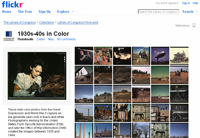The Library of Congress Prints and Photographs Division collections are known for their great photographic treasures – with over 1 million digitized items currently available online. Beginning in January 2008, the Library joined forces with the popular photo sharing site Flickr to provide a new avenue to the Library’s photos and build new levels of interaction with the public.
Why were photo collections chosen for this project? The Prints and Photographs Division is interested in new ways to make its resources known and has long relied on volunteers to help describe pictures that lack full captions. The desire to put pictures where millions of people gather virtually in social networks combined with a strong tradition of volunteer assistance made a good match for the web 2.0 world of user-generated content.
Michelle Springer, a Project Manager at the Library of Congress, points out that "photos have the advantage of being interesting to a wide variety of audiences, and can be appreciated on many levels regardless of native language or expertise."
In addition, the Library was looking for a way to be more involved in web 2.0 activities. Flickr was selected as an established and well-respected public forum for photos that offered the functionality to easily collect community descriptions and comments. After coordinating with Flickr to provide the proper rights statement, the Library of Congress Flickr pilot project was launched.

An image from the George Grantham Bain Collection that represents the millionth item scanned for the Prints & Photographs Division at the Library of Congress.
The initial project included about 3,000 of the Library’s photos from two different collections: the Farm Security Administration/Office of War Information collection (color photos from the 1930s and 1940s) and the George Grantham Bain News Service collection (black-and-white photos from the early 1900s). These photo collections were chosen for the pilot because they represent a wide range of subjects in both black and white as well as color. No new scanning was involved for this project; only photos already digitized and available through the Library’s website were used.
Another special feature of the Flickr Pilot Project is the way it was announced and publicized. Normally, the Library sends out a formal press release to publicize a project launch. But this project relied exclusively on the web for publicity – in this case, web 2.0. The project was announced only on the Flickr blog (external link) and the Library blog. The news went viral from there as word spread through the blogosphere.
The statistics tell the story of immediate as well as long-term success. In the first 24 hours after launch Flickr reported 1.1 million views on the Library’s account, with 3.6 million total views a week later. Once the initial curiosity abated, the ongoing pace showed sustained interest from new audiences, with a current average of over 800,000 page views per month. While the major activity is viewing the photos, other popular features are the ability to add comments as well as "tags," or keywords, for any item on the site. By April 2009, viewers had submitted over 12,000 comments and over 17,000 unique tags.
Another goal for this project is to draw more viewers to the Library’s website. To that end, the catalog records include links to the collection descriptions and higher resolution images available through the Prints & Photographs Online Catalog.
Prints and Photographs Division staff review all public comments posted to the site each week. Many comments are strictly emotional – such as "great photo" or "love it" – and help to gauge the general favorable reaction to a library making cultural heritage resources more widely available. Other observations offer new information, which Library staff research and verify. This process has resulted in over 500 catalog records being changed or expanded to reflect new, or in some cases corrected, information. Hundreds more records are due to be updated in 2009.
Springer notes that there are regular contributors, dedicated "history detectives," who provide much of this information. "It is particularly gratifying to see Flickr members provide connections between the past and the present through personal histories such as memories of farming practices, grandparent's lives, women's roles in World War II, and the changing landscape of local neighborhoods," she said. Many of the comments include links to established sources such as the New York Times or other specialized websites.
This collaboration with the Library prompted Flickr to launch a new online gathering space called the Flickr Commons (external link), a virtual community of cultural heritage institutions and their freely available online photo collections. The Flickr Commons began with the launch of the Library’s pilot project, and has since grown to include photos from 24 other institutions. The criteria for inclusion are images with no known copyright restrictions that can benefit from enhanced information through public tagging.
To encourage ongoing interest and participation, the Library adds new content on Flickr just about every week. Usually, there are 50 new photos from the very large Bain collection, with monthly additions such as the Photochrom Travel Views collection (external link) and Abraham Lincoln photos (external link) added to coincide with the Lincoln Bicentennial exhibit.
In looking through the Flickr project page it seems obvious why the public is so taken with these photos. In addition to providing a special glimpse into our nations’ history through high-quality photos, Springer says that "people genuinely appreciate the opportunity to provide value to our institution. We gained a deeper understanding of how users want to interact with our collections."
The Library’s successful experiment with Flickr proves that people are indeed interested in contributing to our shared cultural heritage.
For details on the first nine months of the pilot, see For the Common Good: The Library of Congress Flickr Pilot Project report (PDF, 1.3MB).


